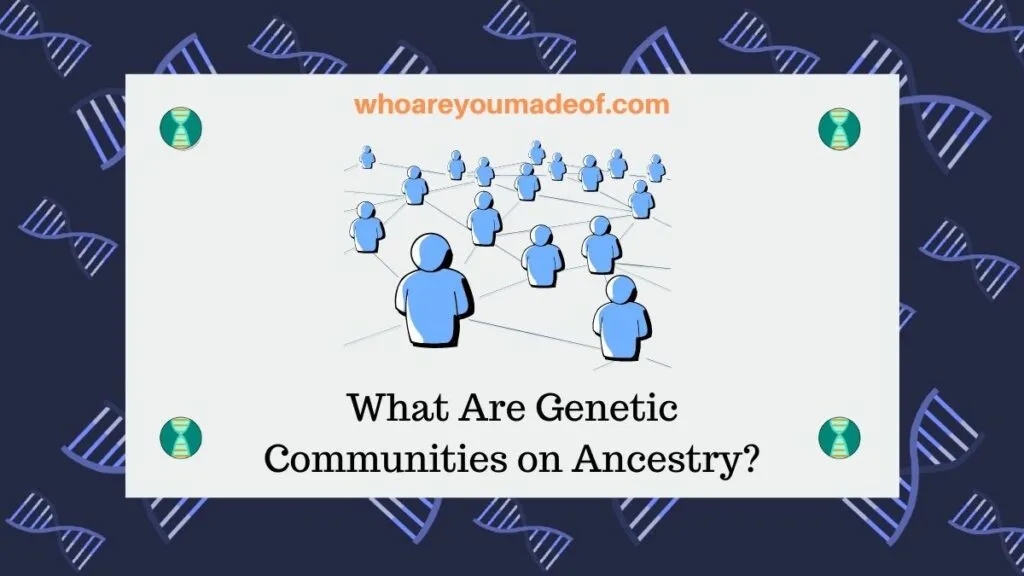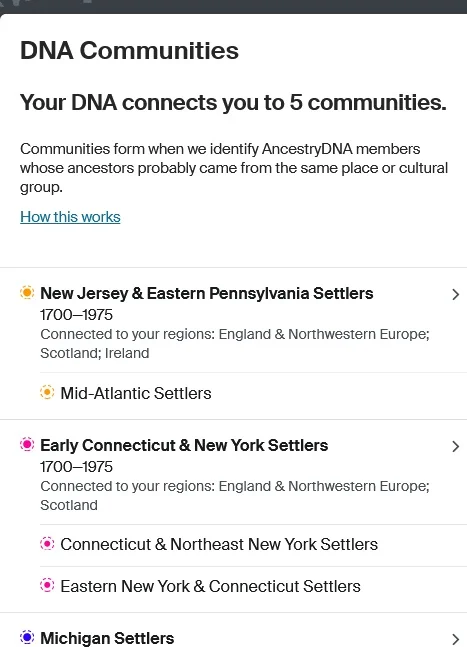Many people who test with Ancestry DNA will receive DNA Communities in their ethnicity estimate. In this post, learn how to understand the communities that show up on your results.
In this article, you will learn:
- What are DNA Communities on AncestryDNA
- Whether they are accurate
- How to use the information you learn
- How to find a list of the available communities

Sometimes the Communities that show up for us can be a bit confusing or surprising, especially if we have no known ancestors who live in the region that the Community covers. I'll cover this topic below, too.
What are DNA Communities on Ancestry?
A DNA Community on Ancestry is a group of Ancestry DNA users who all have a genetic connection to a specific region of the world or cultural group. Members of a DNA Community are probably all descended from a group of people with common ancestors, and had ancestors who traveled to or from a particular part of the world at around the same point in history.
This information is determined by a high-tech analysis of our DNA results and those of tens of millions of other Ancestry DNA customers, as well as the hundreds of millions of family trees hosted on the site. After Ancestry determines that a group of people belong to a DNA Community, they do historical research to try to learn about historical factors that caused this connection.
To belong to a DNA Community means that you are genetically connected to the region that shows up on your results, and that you likely had ancestors who lived there and probably have living relatives in the area today.
How to see your DNA Communities on your Ancestry results
To find whether you match one of more DNA Communities, log in to your Ancestry results and access your main DNA Story page. If you scroll down past your Ethnicity Estimate and Ethnicity Inheritance (SideView), you will see your DNA Communities.
It should look something like this:

Of course, the Communities that show up on your list may be different than those that you find on the image above. Everyone has unique DNA, which is one reason that DNA testing is so much fun and so very interesting.
Are genetic communities accurate?
Ancestry DNA Genetic Communities are very accurate. Close examination of all lines of a verified family tree will almost always reveal a connection to the regions that show up under the DNA Communities heading of ethnicity results.
Back a few years ago, I noticed a region on my DNA Communities section of my Ancestry DNA results that I was surprised to see. My DNA matches the Michigan Settlers, and the more specific "Western Michigan Settlers" sub-Community on Ancestry.

Even though I had a single great-great-great grandmother on my dad's side of the family who was born in Michigan, she had migrated further west to central Illinois, where she had married and lived out the rest of her life.
Her father was from England and her mother had been born in New Jersey. I had always viewed my family story as having "passed through" Michigan, but not really taking place there.
How could simply living in a region lead to a third great-granddaughter having a DNA connection to the area?
DNA results of relatives also verify accuracy
One strategy that we can use to verify the accuracy of our DNA results, especially the DNA Communities, is to see if one or both of our parents also show the Community in their ethnicity estimate.
Both of my parents have taken AncestryDNA tests, and my paternal grandmother has done this, too. In this case, I am able to be sure that my DNA connection to Western Michigan is through my dad's side of the family.
My father and my paternal grandmother also shows Michigan Settlers > Western Michigan in their ethnicity estimates, as does my daughter. My mother shows no genetic connection to this region.
They match family tree information
One genealogy research strategy that I recommend to everyone is to focus on collateral lines of the family tree. We can learn a lot about our ancestors from studying their siblings and others in our tree who are not our direct ancestors.
Using this method, I realized that I do have a strong connection to Western Michigan. While my 3rd great-grandmother didn't live out her entire life there, she had twelve siblings (some half-siblings), many of whom did stay in the area for the course of their lives.
Furthermore, both her mother (NJ) and her father (English), both had siblings who also migrated along with them to Michigan. These siblings also had many children, many of whom also stayed in Michigan.
I probably have large number of distant relatives who live in Michigan, not even taking into account that my ancestors may have also had other relatives, such as cousins, aunts, or uncles, living there that I have not yet discovered.
So yes, the DNA Community feature is very accurate.
How far back is your Genetic Community ancestor?
According to Ancestry, the DNA Community feature of the DNA Story can reveal a genetic connection to a region that is more recent that the regions that show up on the ethnicity estimate. Generally, we expect the ancestral connection to the DNA Community to be between 50-300 years back in the family tree.
In my Michigan Settlers example, the siblings of my great-great-great grandmother were born and started families in the state between about 1860-1880, which fits right into this time frame.
We will see that most of the DNA Communities on our results cover a span of up to about 300 years, at most. Some connections will be more specific, and more recent.
How is an ethnicity region different from a DNA Community?
The primary difference between an ethnicity region and a DNA Community is how far back in time your results can detect a connection. As I mentioned above, DNA Communities go back as little as 50 years.
On the other hand, our connection to the broader regions that we see on our ethnicity estimate can be as far back as 1000 years in time. Most of us will not be able to build any lines of our family tree back that far, so the DNA Communities are more helpful for family tree research because they reveal information about more recent ancestors.
How can DNA communities help you learn about your family tree
The primary way that the DNA Communities on your Ancestry results will help you learn about your family tree is that it can help you be sure about where to focus your research. Since Communities are so accurate, we can feel fairly confident that the right kind of research will lead us to that region.
One of the great things about Ancestry DNA Communities is that if you have a Community on your results, then you might be able to look at the DNA results of either of your parents to see which side of the family tree it came from.
In addition, there are often sub-Communities, or more specific DNA Communities within a broader Genetic Community, that your parents might belong to, even if it didn't show up in your results. This is a great reason to ask our parents to take DNA tests, if at all possible.
Where to find a list of genetic communities
When the Genetic Communities feature first launched in about 2017, there were around 300 distinct communities that could be matched with our DNA. The technology and data behind the tool has grown, and we can now learn if our DNA matches to more than 1500 ethnicity regions, sub-regions, and DNA Communities.
You can find a list of all regions on Ancestry DNA on the paged linked to below. To find DNA Communities under specific ethnicity regions, scroll down to that region and then find DNA Communities listed under the broader ethnicity region.
Conclusion
I hope that this post has helped you learn the basics of the Genetic DNA Communities on Ancestry, and how you can use this information to learn more about your Ancestry. This feature is just one many ways to learn about your family tree on Ancestry.
If you have any questions about something that you read in this post, or if you have a question about a specific community that showed up on your results, please join in the discussion below by leaving a comment.
Thanks for reading today!

Gregory O'Shea
Tuesday 5th of March 2024
Thanks for walking through this. I've been looking for an explanation of how I got Japan as a community as my ethnicity and that of my parents, is hyper-focused on Ireland and nearby to there. Japan is a major curveball and I see no connection to that community on either of my parents. My father's maternal gf (McBride) was a shipping agent in San Francisco and dealt heavily with Japan and China, so I'm starting to explore that as a possible connection. Your estimation of 5-300 year window would put him solidly in there. Maybe I've got some cousins I never knew about through his association with that community.